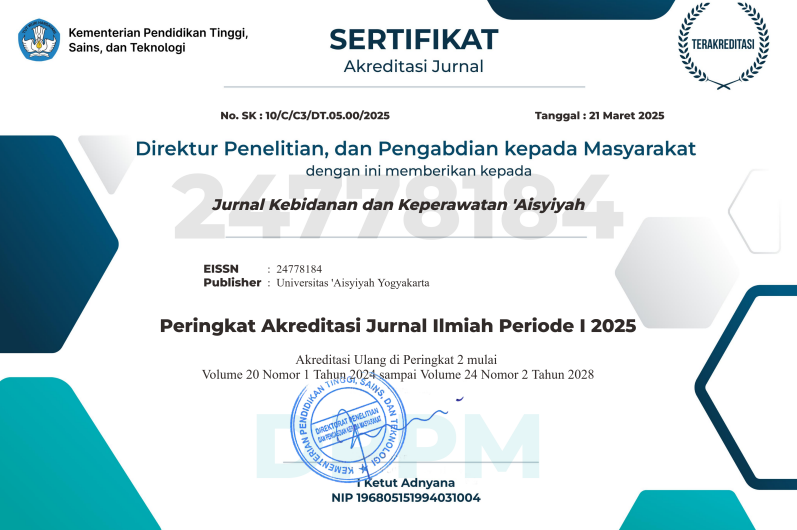Dampak rupture perineum pada ibu postpartum: studi kualitatif
DOI:
https://doi.org/10.31101/jkk.1524Abstract views 1690 times
Keywords:
dampak, postpartum, rupture perineumAbstract
Downloads
References
Abedzadeh-Kalahroudi, M., Talebian, A., Sadat, Z., & Mesdaghinia, E. (2019). Perineal trauma: Incidence and its risk factors. Journal of Obstetrics and Gynaecology, 39(2), 206–211. https://doi.org/10.1080/01443615.2018.1476473
Artymuk, N. V., & Khapacheva, S. Y. (2020). Device-assisted pelvic floor muscle postpartum exercise programme for the management of pelvic floor dysfunction after delivery. The Journal of Maternal-Fetal & Neonatal Medicine, 1–5. https://doi.org/10.1080/14767058.2020.1723541
Braun, V., & Clarke, V. (2014). What can “thematic analysis†offer health and wellbeing researchers? International Journal of Qualitative Studies on Health and Well-Being, 9(1), 26152. https://doi.org/10.3402/qhw.v9.26152
Crookall, R., Fowler, G., Wood, C., & Slade, P. (2018). A systematic mixed studies review of women’s experiences of perineal trauma sustained during childbirth. Journal of Advanced Nursing, 74(9), 2038–2052. https://doi.org/10.1111/jan.13724
Darmody, E., Bradshaw, C., & Atkinson, S. (2020). Women’s experience of obstetric anal sphincter injury following childbirth: An integrated review. Midwifery, 91, 102820. https://doi.org/10.1016/j.midw.2020.102820
Departemen Agama Republik Indonesia. (2015). Al-Qur’an Terjemahan. Bandung : CV Darus Sunnah.
Dunn, A. B., Paul, S., Ware, L. Z., & Corwin, E. J. (2015). Perineal Injury During Childbirth Increases Risk of Postpartum Depressive Symptoms and Inflammatory Markers. Journal of Midwifery & Women’s Health, 60(4), 428–436. https://doi.org/10.1111/jmwh.12294
East, C. E., Dorward, E. D., Whale, R. E., & Liu, J. (2020). Local cooling for relieving pain from perineal trauma sustained during childbirth. Cochrane Database of Systematic Reviews, 2020(10). https://doi.org/10.1002/14651858.CD006304.pub4
Edqvist, M., Lindgren, H., & Lundgren, I. (2014). Midwives’ lived experience of a birth where the woman suffers an obstetric anal sphincter injury—A phenomenological study. BMC Pregnancy and Childbirth, 14(1), 258. https://doi.org/10.1186/1471-2393-14-258
Forey, P.-L., Lallemant, M., Bourtembourg-Matras, A., Eckman-Lacroix, A., Ramanah, R., Riethmuller, D., & Mottet, N. (2020). Impact of a selective use of episiotomy combined with Couder’s maneuver for the perineal protection. Archives of Gynecology and Obstetrics, 302(1), 77–83. https://doi.org/10.1007/s00404-020-05572-9
Franchi, M., Parissone, F., Lazzari, C., Garzon, S., Laganà , A. S., Raffaelli, R., Cromi, A., & Ghezzi, F. (2020). Selective use of episiotomy: What is the impact on perineal trauma? Results from a retrospective cohort study. Archives of Gynecology and Obstetrics, 301(2), 427–435. https://doi.org/10.1007/s00404-019-05404-5
Gebuza, G., Kaźmierczak, M., Gdaniec, A., Mieczkowska, E., Gierszewska, M., Dombrowska-Pali, A., Banaszkiewicz, M., & Maleńczyk, M. (2018). Episiotomy and perineal tear risk factors in a group of 4493 women. Health Care for Women International, 39(6), 663–683. https://doi.org/10.1080/07399332.2018.1464004
Gommesen, D., Nohr, E. A., Drue, H. C., Qvist, N., & Rasch, V. (2019). Obstetric perineal tears: Risk factors, wound infection and dehiscence: a prospective cohort study. Archives of Gynecology and Obstetrics, 300(1), 67–77. https://doi.org/10.1007/s00404-019-05165-1
Ikatan Bidan Indonesia. (2016). Filosofi Kami. Diakses di https://ibi.or.id pada 2 Januari 2022
Jiang, H., Qian, X., Carroli, G., & Garner, P. (2017). Selective versus routine use of episiotomy for vaginal birth. Cochrane Database of Systematic Reviews, 2017(2). https://doi.org/10.1002/14651858.CD000081.pub3
Lindqvist, M., Persson, M., Nilsson, M., Uustal, E., & Lindberg, I. (2018). ’A worse nightmare than expected’—A Swedish qualitative study of women’s experiences two months after obstetric anal sphincter muscle injury. Midwifery, 61, 22–28. https://doi.org/10.1016/j.midw.2018.02.015
M. Amorim, M., Coutinho, I. C., Melo, I., & Katz, L. (2017). Selective episiotomy vs. implementation of a non-episiotomy protocol: A randomized clinical trial. Reproductive Health, 14(1), 55. https://doi.org/10.1186/s12978-017-0315-4
Pierce-Williams, R. A. M., Saccone, G., & Berghella, V. (2021). Hands-on versus hands-off techniques for the prevention of perineal trauma during vaginal delivery: A systematic review and meta-analysis of randomized controlled trials. The Journal of Maternal-Fetal & Neonatal Medicine, 34(6), 993–1001. https://doi.org/10.1080/14767058.2019.1619686
Priddis, H., Schmied, V., & Dahlen, H. (2014). Women’s experiences following severe perineal trauma: A qualitative study. BMC Women’s Health, 14(1), 32. https://doi.org/10.1186/1472-6874-14-32
Quoc Huy, N. V., Phuc An, L. S., Phuong, L. S., & Tam, L. M. (2019). Pelvic Floor and Sexual Dysfunction After Vaginal Birth With Episiotomy in Vietnamese Women. Sexual Medicine, 7(4), 514–521. https://doi.org/10.1016/j.esxm.2019.09.002
Schreiner, L., Crivelatti, I., de Oliveira, J. M., Nygaard, C. C., & dos Santos, T. G. (2018). Systematic review of pelvic floor interventions during pregnancy. International Journal of Gynecology & Obstetrics, 143(1), 10–18. https://doi.org/10.1002/ijgo.12513
Schwab-Reese, L. M., Ramirez, M., Ashida, S., & Peek-Asa, C. (2017). Psychosocial employment characteristics and postpartum maternal mental health symptoms: Psychosocial Postpartum Employment. American Journal of Industrial Medicine, 60(1), 109–120. https://doi.org/10.1002/ajim.22666
Smith, V., Gallagher, L., Carroll, M., Hannon, K., & Begley, C. (2019). Antenatal and intrapartum interventions for reducing caesarean section, promoting vaginal birth, and reducing fear of childbirth: An overview of systematic reviews. PLOS ONE, 14(10), e0224313. https://doi.org/10.1371/journal.pone.0224313
Soave, I., Scarani, S., Mallozzi, M., Nobili, F., Marci, R., & Caserta, D. (2019). Pelvic floor muscle training for prevention and treatment of urinary incontinence during pregnancy and after childbirth and its effect on urinary system and supportive structures assessed by objective measurement techniques. Archives of Gynecology and Obstetrics, 299(3), 609–623. https://doi.org/10.1007/s00404-018-5036-6
Sobhgol, S. S., Priddis, H., Smith, C. A., & Dahlen, H. G. (2019). Evaluation of the effect of an antenatal pelvic floor muscle exercise programme on female sexual function during pregnancy and the first 3 months following birth: Study protocol for a pragmatic randomised controlled trial. Trials, 20(1), 144. https://doi.org/10.1186/s13063-019-3226-6
Ugwu, E. O., Iferikigwe, E. S., Obi, S. N., Eleje, G. U., & Ozumba, B. C. (2018). Effectiveness of antenatal perineal massage in reducing perineal trauma and post-partum morbidities: A randomized controlled trial: APM for preventing perineal trauma. Journal of Obstetrics and Gynaecology Research, 44(7), 1252–1258. https://doi.org/10.1111/jog.13640
Woodley, S. J., Boyle, R., Cody, J. D., Mørkved, S., & Hay-Smith, E. J. C. (2017). Pelvic floor muscle training for prevention and treatment of urinary and faecal incontinence in antenatal and postnatal women. Cochrane Database of Systematic Reviews. https://doi.org/10.1002/14651858.CD007471.pub3
Downloads
Additional Files
Published
How to Cite
Issue
Section
License
With the receipt of the article by the Jurnal Kebidanan dan Keperawatan Aisyiyah Editorial Board and the decision to be published, then the copyright regarding the article will be diverted to Jurnal Kebidanan dan Keperawatan Aisyiyah. Universitas 'Aisyiyah Yogyakarta as the publisher of Jurnal Kebidanan dan Keperawatan Aisyiyah hold the copyright regarding all the published articles in this journal.
Jurnal Kebidanan dan Keperawatan Aisyiyah is licensed under a Creative Commons Attribution-ShareAlike 4.0 International License.
















